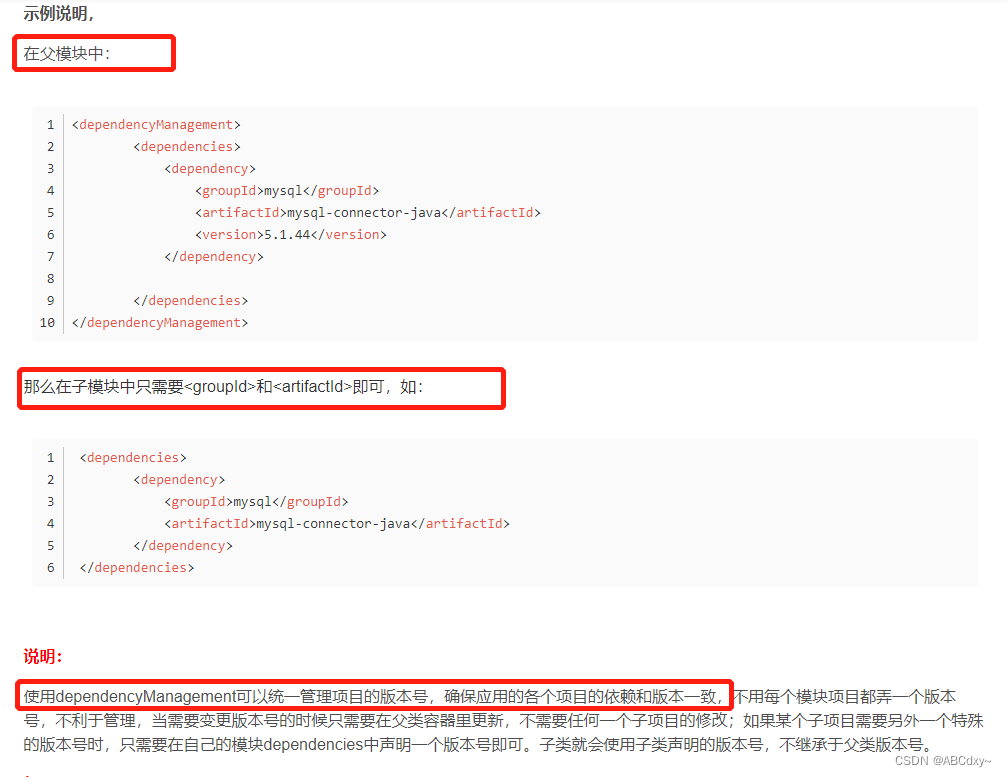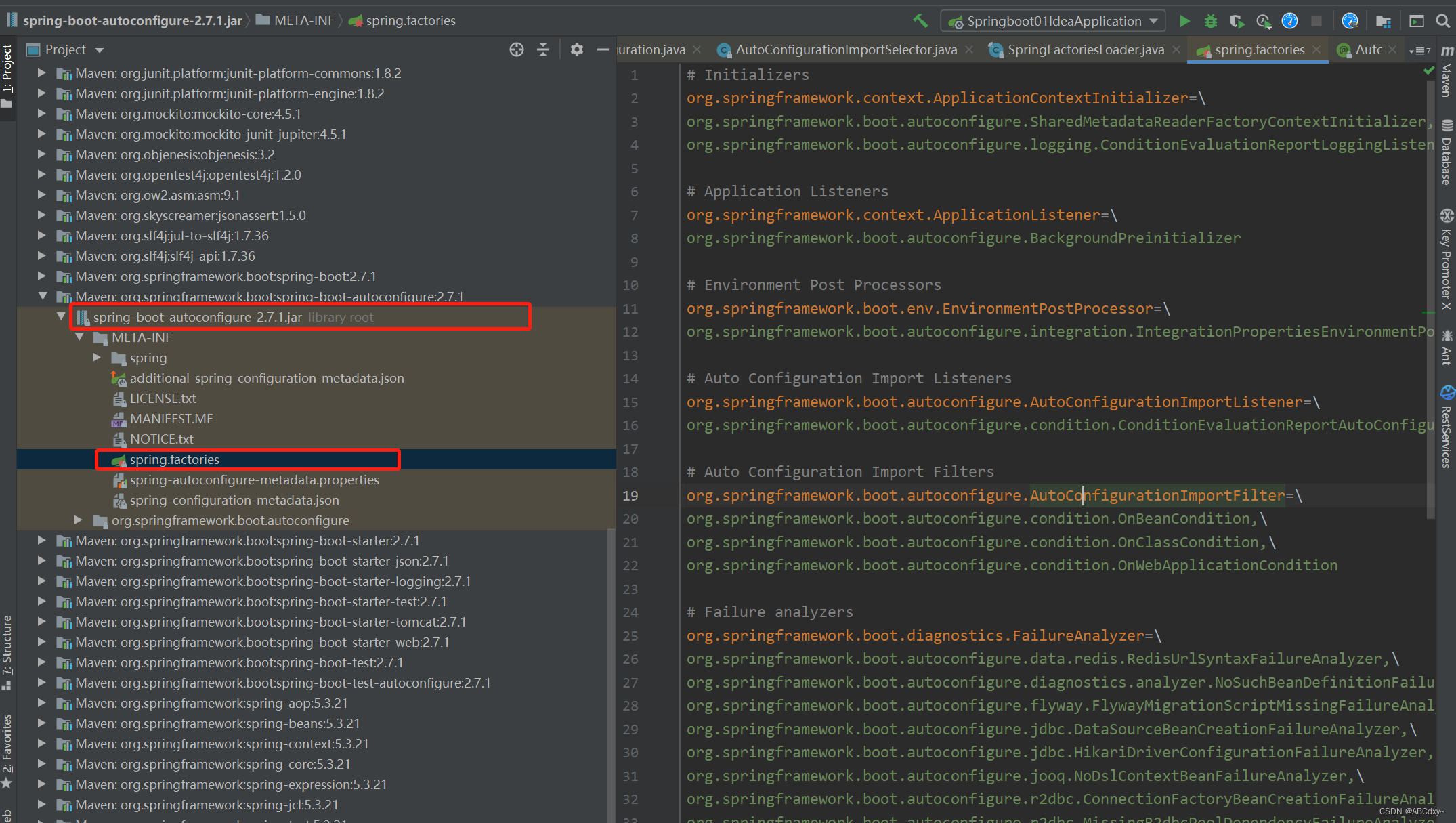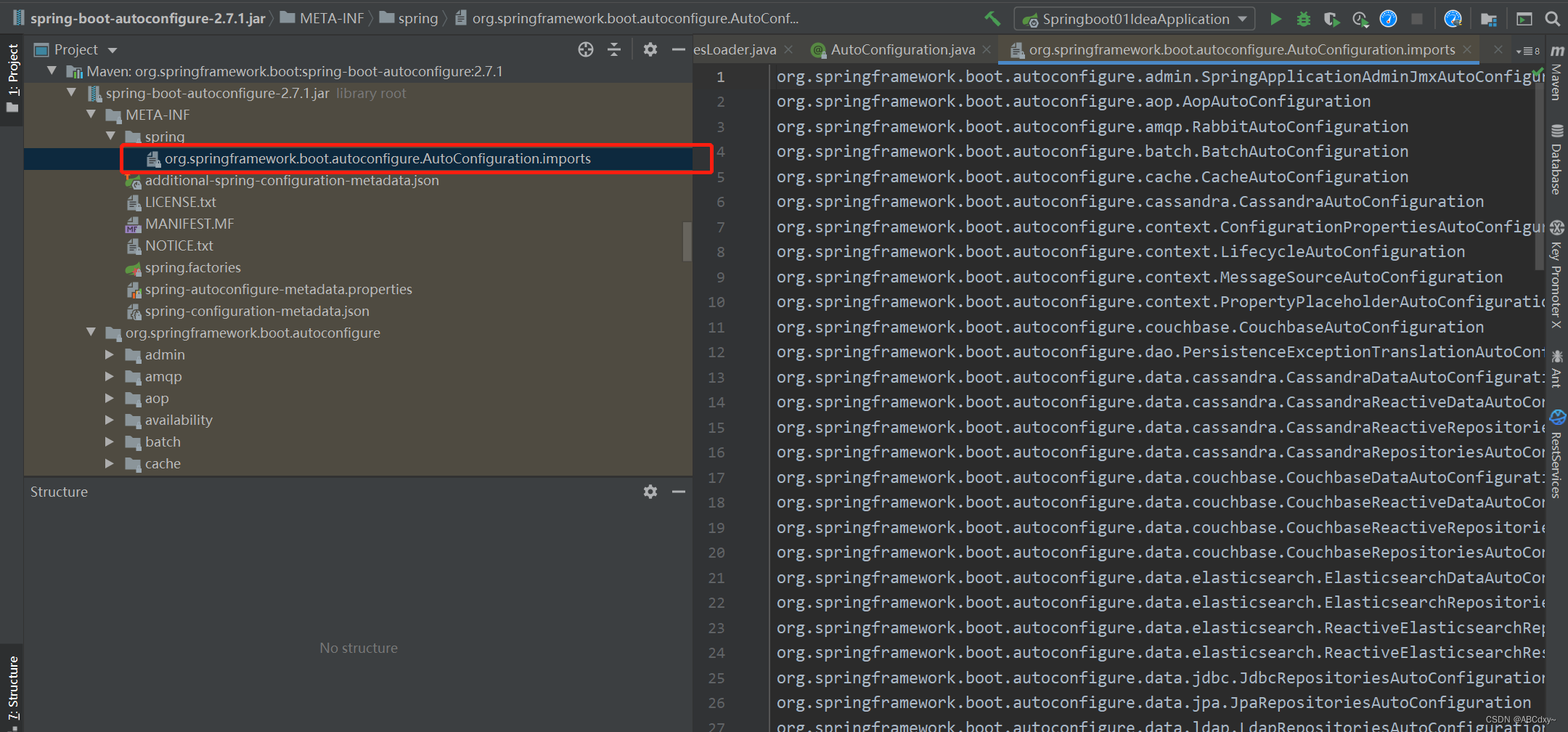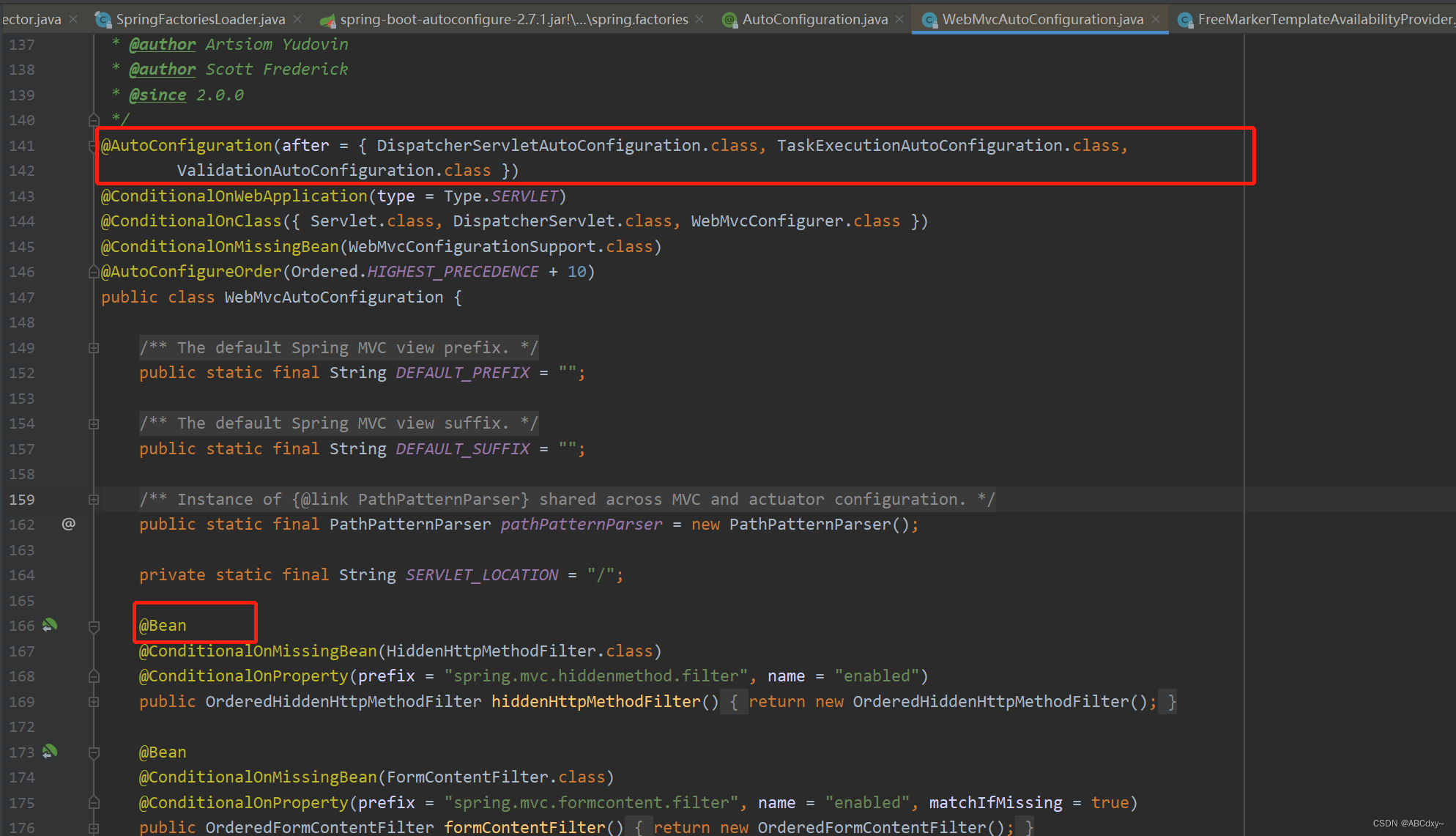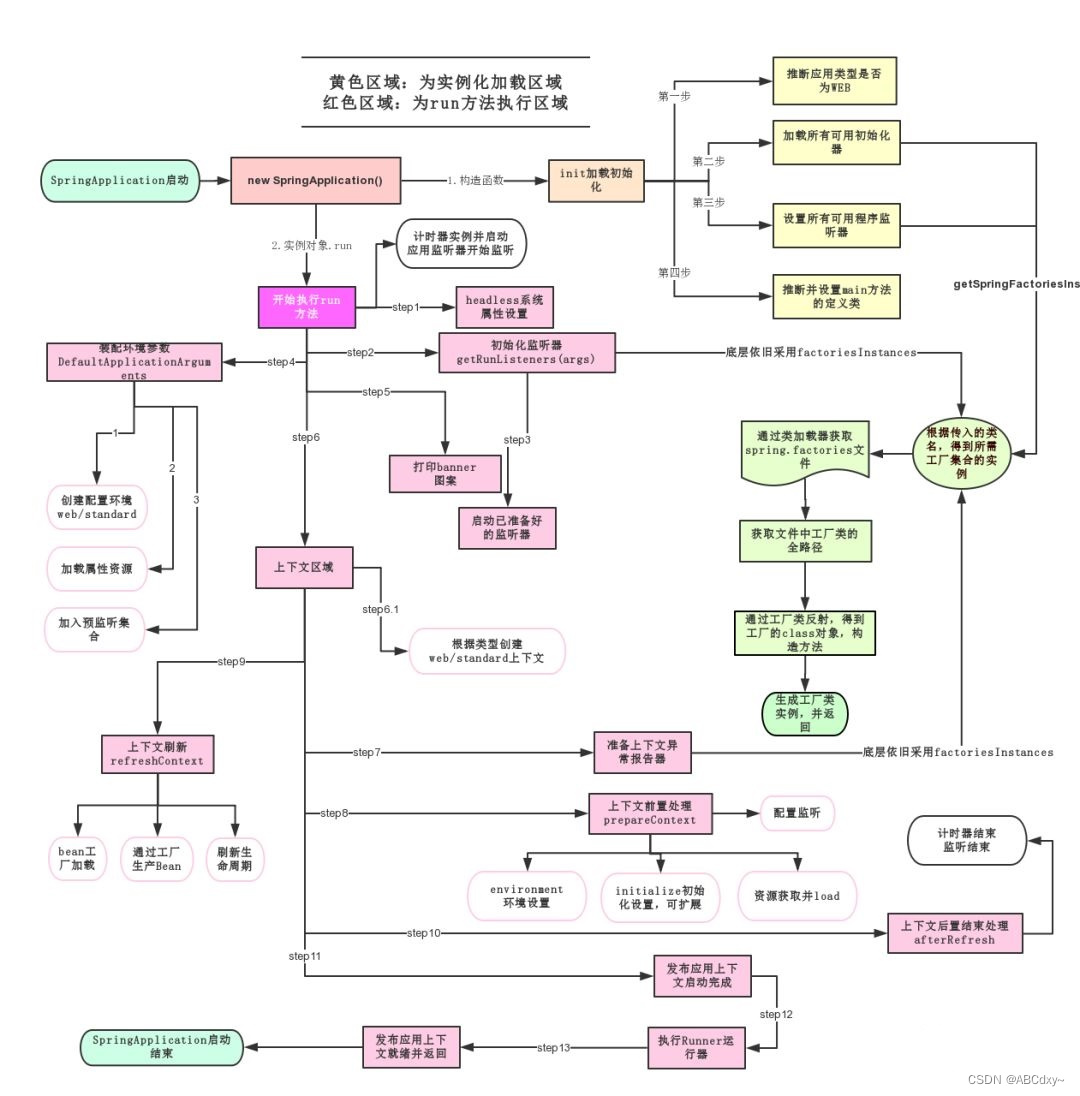pom.xml
父依赖
其中它主要是依赖一个父项目,主要是管理项目的资源过滤及插件!
<parent>
<groupId>org.springframework.boot</groupId>
<artifactId>spring-boot-starter-parent</artifactId>
<version>2.7.1</version>
<relativePath/> <!-- lookup parent from repository -->
</parent>点进去,发现还有一个父依赖
<!-- ... -->
<parent>
<groupId>org.springframework.boot</groupId>
<artifactId>spring-boot-dependencies</artifactId>
<version>2.7.1</version>
</parent>
<!-- ... -->再点进去,这里才是真正管理SpringBoot应用里面所有依赖版本的地方,SpringBoot的版本控制中心;
以后我们导入依赖默认是不需要写版本;但是如果导入的包没有在依赖中管理着就需要手动配置版本了;
启动器spring-boot-starter
<!-- ... -->
<dependency>
<groupId>org.springframework.boot</groupId>
<artifactId>spring-boot-starter-web</artifactId>
</dependency>
<!-- ... -->springboot-boot-starter-xxx:就是spring-boot的场景启动器
spring-boot-starter-web:帮我们导入了web模块正常运行所依赖的组件
SpringBoot将所有的功能场景都抽取出来,做成一个个的starter (启动器),只需要在项目中引入这些starter即可,所有相关的依赖都会导入进来 , 我们要用什么功能就导入什么样的场景启动器即可 ;我们未来也可以自己自定义 starter;
拓展:maven中的dependencyManagement
主启动类
默认的主启动类
import org.springframework.boot.SpringApplication;
import org.springframework.boot.autoconfigure.SpringBootApplication;
//程序的主入口
@SpringBootApplication
public class HelloworldApplication {
public static void main(String[] args) {
SpringApplication.run(HelloworldApplication.class, args);
}
}@SpringBootApplication
作用:标注在某个类上说明这个类是SpringBoot的主配置类 , SpringBoot就应该运行这个类的main方法来启动SpringBoot应用;
进入这个注解:可以看到上面还有很多其他注解!
@SpringBootConfiguration
作用:springboot的配置类,标准在某个类上,表示这是一个springboot的配置类
点进去这个注解,查看
//...
@Configuration
@Indexed
public @interface SpringBootConfiguration {
//...
}
//...@Configuration
//...
@Component
public @interface Configuration {
//...
}
//...这里的@Component,说明这个一个配置类,配置类就是对应spring的xml配置文件
里面的@Component这就说明启动类本身也是spring中的一个组件,负责启动应用
@EnableAutoConfiguration开启自助配置功能
以前我们需要自己配置的东西,现在springboot可以自助帮我们配置
@EnableAutoConfiguration告诉springboot开启启动配置功能,这样自动配置才能生效
//...
@AutoConfigurationPackage
@Import(AutoConfigurationImportSelector.class)
public @interface EnableAutoConfiguration {
//...
}
//...@AutoConfigurationPackage自动配置包
//...
@Import(AutoConfigurationPackages.Registrar.class)
public @interface AutoConfigurationPackage {
//...
}
//...@Import:spring底层注解@Import,给容器中导入一个组件
Registrar.class作用:将主启动类的所在包及包下面所有子包里面的所有㢟扫描到spring容器
@Import(AutoConfigurationImportSelector.class)给容器导入组件
AutoConfigurationImportSelector:自助配置导入选择器
那么它会导入哪些组件的选择器呢?我们点开一下源码:
1.这个类中有一个这样的方法
// 获取候选配置
protected List<String> getCandidateConfigurations(AnnotationMetadata metadata, AnnotationAttributes attributes) {
List<String> configurations = new ArrayList<>(
SpringFactoriesLoader.loadFactoryNames(getSpringFactoriesLoaderFactoryClass(), getBeanClassLoader()));
ImportCandidates.load(AutoConfiguration.class, getBeanClassLoader()).forEach(configurations::add);
Assert.notEmpty(configurations,
"No auto configuration classes found in META-INF/spring.factories nor in META-INF/spring/org.springframework.boot.autoconfigure.AutoConfiguration.imports. If you "
+ "are using a custom packaging, make sure that file is correct.");
return configurations;
}
注意这句(新版本看META-INF/spring/org.springframework.boot.autoconfigure.AutoConfiguration.imports)
No auto configuration classes found in META-INF/spring.factories
nor
in META-INF/spring/org.springframework.boot.autoconfigure.AutoConfiguration.imports.
If you are using a custom packaging, make sure that file is correct.
2.这个方法又调用了SpringFactoriesLoader的静态方法,我们进去loadFactoryNames方法
public static List<String> loadFactoryNames(Class<?> factoryType, @Nullable ClassLoader classLoader) {
ClassLoader classLoaderToUse = classLoader;
if (classLoaderToUse == null) {
classLoaderToUse = SpringFactoriesLoader.class.getClassLoader();
}
String factoryTypeName = factoryType.getName();
//这里又调用了loadSpringFactories方法
return loadSpringFactories(classLoaderToUse).getOrDefault(factoryTypeName, Collections.emptyList());
}3.我们继续点击查看loadSpringFactories方法
private static Map<String, List<String>> loadSpringFactories(ClassLoader classLoader) {
Map<String, List<String>> result = cache.get(classLoader);
if (result != null) {
return result;
}
result = new HashMap<>();
try {
Enumeration<URL> urls = classLoader.getResources(FACTORIES_RESOURCE_LOCATION);
while (urls.hasMoreElements()) {
URL url = urls.nextElement();
UrlResource resource = new UrlResource(url);
Properties properties = PropertiesLoaderUtils.loadProperties(resource);
for (Map.Entry<?, ?> entry : properties.entrySet()) {
String factoryTypeName = ((String) entry.getKey()).trim();
String[] factoryImplementationNames =
StringUtils.commaDelimitedListToStringArray((String) entry.getValue());
for (String factoryImplementationName : factoryImplementationNames) {
result.computeIfAbsent(factoryTypeName, key -> new ArrayList<>())
.add(factoryImplementationName.trim());
}
}
}
// Replace all lists with unmodifiable lists containing unique elements
result.replaceAll((factoryType, implementations) -> implementations.stream().distinct()
.collect(Collectors.collectingAndThen(Collectors.toList(), Collections::unmodifiableList)));
cache.put(classLoader, result);
}
catch (IOException ex) {
throw new IllegalArgumentException("Unable to load factories from location [" +
FACTORIES_RESOURCE_LOCATION + "]", ex);
}
return result;
}FACTORIES_RESOURCE_LOCATION
public static final String FACTORIES_RESOURCE_LOCATION = "META-INF/spring.factories";
4.发现一个多次出现的文件:spring.factories,全局搜索它
spring.factories (ps:最新的版本将被弃用)
我们根据源头打开spring.factories , 看到了很多自动配置的文件;这就是自动配置根源所在!
新版本看
我们在上面的自动配置类随便找一个打开看看,比如 :WebMvcAutoConfiguration
@AutoConfiguration
//...
@Configuration(proxyBeanMethods = false)
@AutoConfigureBefore
@AutoConfigureAfter
public @interface AutoConfiguration {
//...
}
//...可以看到这些一个个的都是JavaConfig配置类,而且都注入了一些Bean,可以找一些自己认识的类,看着熟悉一下!
所以,自动配置真正实现是从classpath中搜寻所有的META-INF/spring.factories配置文件 ,并将其中对应的 org.springframework.boot.autoconfigure. 包下的配置项,通过反射实例化为对应标注了 @Configuration的JavaConfig形式的IOC容器配置类 , 然后将这些都汇总成为一个实例并加载到IOC容器中。
结论
-
springboot在启动的时候从类路径在的META-INF/spring.factories中获取@EnableAutoConfiguration指定的值(新版本从
META-INF/spring/org.springframework.boot.autoconfigure.AutoConfiguration.imports中获取) -
将这些值作为自动配置类导入容器,自助配置类就生效,帮我们进行自动配置工作
-
整个J2EE的整体解决方法和自动配置都在springboot-autoconfigure的jar包中
-
它会给容器中导入非常多的自动配置类(***AutoConfiguration),就是给容器中导入这个场景需要的所有组件,并配置好这些组件
-
有了自动配置类,免去了我们手动编写配置注入功能组件等的工作
SpringApplication
我最初以为就是运行了一个main方法,没想到却开启了一个服务;
//...
@SpringBootApplication
public class Springboot01IdeaApplication {
public static void main(String[] args) {
SpringApplication.run(Springboot01IdeaApplication.class, args);
}
}SpringApplication.run分析
分析该方法主要分两部分,一部分是SpringApplication的实例化,二是run方法的执行;
SpringApplication
这个类主要做了以下四件事情:
-
推断应用的类型是普通的项目还是web项目
-
查找并加载所有可用初始化器,设置到initializers属性中
-
找出所有的应用程序监听器,设置到listeners属性中
-
推断并设置main方法的定义类,找到运行的主类
查看构造器:
//...
public SpringApplication(ResourceLoader resourceLoader, Class<?>... primarySources) {
this.resourceLoader = resourceLoader;
Assert.notNull(primarySources, "PrimarySources must not be null");
this.primarySources = new LinkedHashSet<>(Arrays.asList(primarySources));
this.webApplicationType = WebApplicationType.deduceFromClasspath();
this.bootstrapRegistryInitializers = new ArrayList<>(
getSpringFactoriesInstances(BootstrapRegistryInitializer.class));
setInitializers((Collection) getSpringFactoriesInstances(ApplicationContextInitializer.class));
setListeners((Collection) getSpringFactoriesInstances(ApplicationListener.class));
this.mainApplicationClass = deduceMainApplicationClass();
}
//...run方法流程分析
